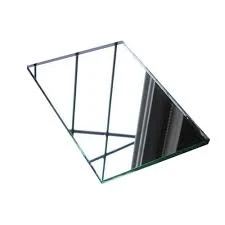

Translucent Mirror Glass A Blend of Aesthetics and Functionality
In the world of contemporary design and architecture, transparency has always played a pivotal role. Among the most innovative materials contributing to this trend is translucent mirror glass. This remarkable material beautifully melds aesthetics with functionality, facilitating a new realm of possibilities in both residential and commercial spaces.
Translucent mirror glass is a unique product that offers a high degree of light diffusion while also incorporating the reflective qualities of a traditional mirror. At first glance, it presents a silvery sheen, but when illuminated, it allows light to penetrate, creating a soft glow that enhances the ambiance of any room. The balance between opacity and reflectivity makes this glass an extraordinary material that can transform environments.
One of the primary advantages of translucent mirror glass is its ability to enhance natural light within a space. Unlike traditional opaque walls that absorb light, translucent glass allows daylight to filter through, illuminating interiors without compromising privacy. This characteristic is particularly invaluable in urban environments where natural light may be scarce. By strategically incorporating translucent mirror glass in windows, walls, or partitions, designers can create brighter, more inviting spaces that promote well-being and productivity.
From a design perspective, translucent mirror glass adds an element of sophistication and modernity to any space. Its sleek appearance can elevate the aesthetic of both residential and commercial settings. In homes, it can be featured in bathrooms, living areas, and even kitchens, serving as an elegant focal point. Commercially, it finds applications in retail environments, restaurants, and office buildings, where it can promote a dynamic atmosphere while maintaining a sense of openness.
Another fascinating aspect of translucent mirror glass is its versatility in applications
. It can be used to create stunning installations, partitions, or even furniture pieces. The glass can be custom-cut and treated to suit various design requirements, allowing architects and designers to experiment with different shapes, sizes, and textures. This adaptability has made it a favorite among modern architects seeking innovative solutions to traditional design challenges.
In addition to visual appeal, translucent mirror glass is a practical choice for energy efficiency. By allowing natural light to fill a space, it reduces the reliance on artificial lighting during the day, leading to lower energy consumption and cost savings. Furthermore, many manufacturers produce this glass with thermal insulation properties, helping to regulate indoor temperatures and enhance the overall energy performance of buildings.
Safety is another essential consideration with translucent mirror glass. Many products come tempered or laminated, providing strength and durability that ensure longevity and resistance to breakage. This quality makes them suitable for high-traffic areas or environments where safety is a concern. In the hands of skilled designers and architects, this glass can contribute to both safe and aesthetically pleasing environments.
The mounting popularity of translucent mirror glass is also tied to its eco-friendly attributes. As sustainability becomes a more significant consideration in design and architecture, materials that promote energy efficiency and natural lighting are increasingly in demand. Using translucent mirror glass can align with green building practices by reducing energy consumption and improving indoor environmental quality.
As trends in design continue to evolve, the use of translucent mirror glass is likely to expand further. With ongoing innovations in technology, we can expect the development of even more advanced products, including those that adapt or change based on environmental conditions. This would open up new opportunities for creative applications and even more profound interactions between spaces and their users.
In conclusion, translucent mirror glass is not just a functional material; it is an artistic canvas that harmonizes aesthetics with utility. Its potential to transform spaces, enhance natural light, and contribute to energy efficiency makes it a compelling choice for modern architects and designers. As we move forward in our pursuit of sustainable, beautiful spaces, translucent mirror glass stands at the forefront, reflecting our aspirations while illuminating our environments.